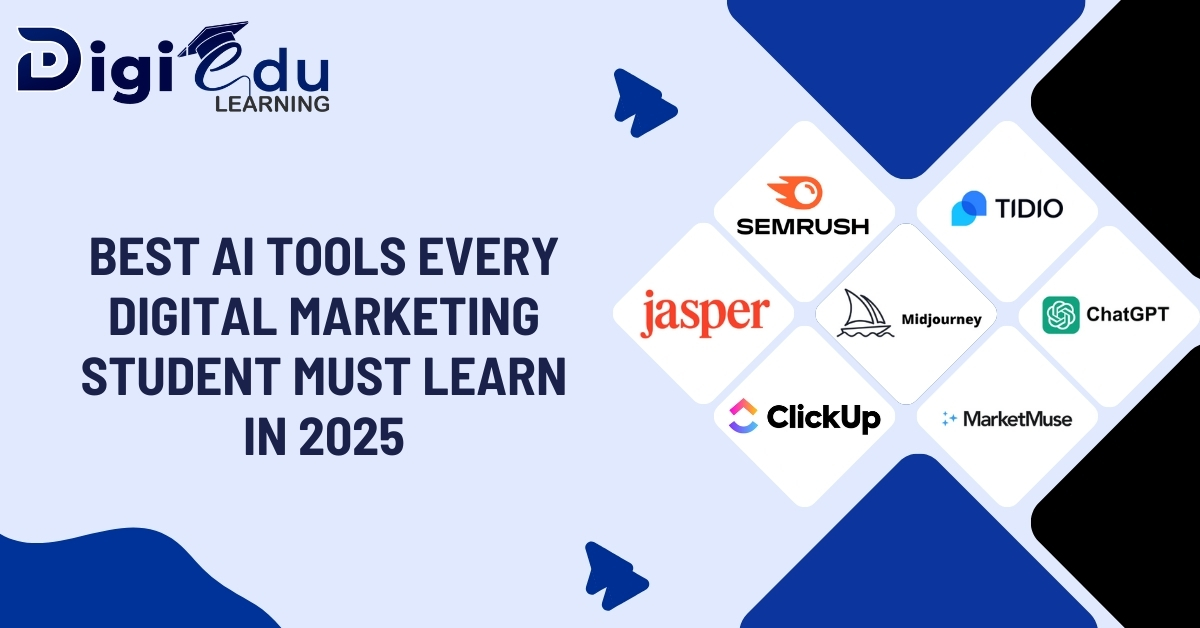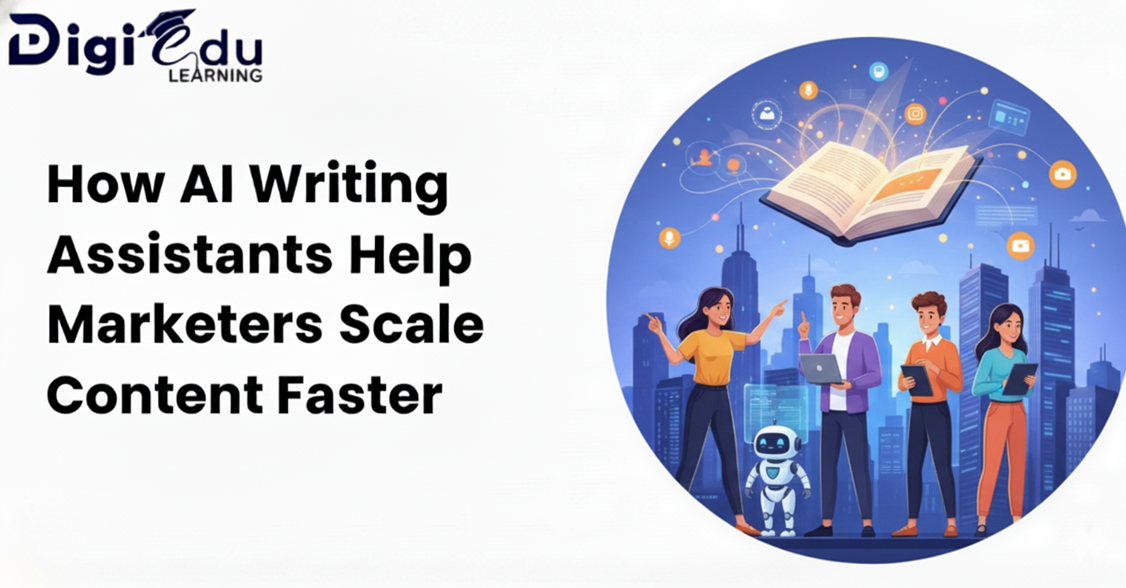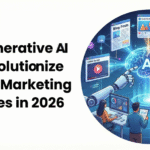Best AI Tools Every Digital Marketing Student Must Learn in 2025

The digital marketing industry is evolving at lightning speed, and 2025 is the year where Artificial Intelligence (AI) is shaping almost every strategy. From content creation and social media marketing to analytics and paid advertising, AI is no longer a futuristic concept but a day-to-day necessity. For digital marketing students, learning AI tools is no longer optional; it is the key to staying employable, competitive, and creative. The best AI tools for digital marketing not only save time but also provide insights, improve personalization, and ensure higher return on investment for campaigns. This blog explores the top AI tools every digital marketing student must master in 2025, along with tips, tricks, and the kind of skills these tools help develop.
The Role of AI in Digital Marketing Education
AI has transformed the way marketing is taught and practiced. Instead of spending hours on manual keyword research, campaign reporting, or brainstorming headlines, students can now use AI-powered platforms to generate accurate results in seconds. This doesn’t mean AI replaces creativity — rather, it enhances it. For students, the challenge is to learn how to combine creativity with AI-driven insights to design strategies that truly stand out.
By using AI tools during their coursework and internships, students learn how to:
- Create SEO-friendly content
- Automate repetitive tasks
- Analyze audience behavior
- Personalize campaigns
- Build data-driven marketing strategies
Let’s dive into the most important AI tools for 2025 that every aspiring marketer should know.
1. AI Tools for Content Creation
ChatGPT
One of the most powerful AI tools, ChatGPT by OpenAI, is helping students generate blogs, ad copies, and even customer support scripts. It is not just about producing words, but about structuring content ideas, researching competitors, and preparing campaign strategies. Students who learn to prompt effectively can turn ChatGPT into a virtual marketing assistant.
Jasper AI and Copy.ai
Both Jasper AI and Copy.ai are industry favorites for creating long-form blogs, catchy ad headlines, and social media captions. They allow marketers to write in different tones and formats, making them ideal for students experimenting with brand voices. These platforms also save time in assignments where speed and quality both matter.
Grammarly and QuillBot
No matter how well you write, grammar and clarity always need polishing. Grammarly ensures that content is professional, while QuillBot helps in paraphrasing and improving readability. Together, these tools help students create content that feels more natural and free of errors, which is crucial for SEO rankings.

2. AI Tools for SEO and Analytics
SurferSEO and Frase.io
Writing content without SEO knowledge is like cooking without salt. Tools like SurferSEO and Frase.io guide students on keyword density, structure, and competitor gaps. They provide scoring systems that help students create blogs aligned with Google’s expectations, a skill every company demands from freshers.
SEMrush and Ahrefs
These are the backbone of SEO research. From keyword tracking to backlink audits, SEMrush and Ahrefs use AI to predict search trends and offer suggestions that actually work. For students, practicing on these tools means understanding how real businesses compete for rankings.
Google Analytics 4
The upgraded Google Analytics 4 (GA4) integrates AI to provide predictive insights like customer lifetime value and purchase probability. Students who master GA4 not only learn reporting but also forecasting — a skill that turns data into actionable strategies.
3. AI Tools for Social Media Marketing
Hootsuite with Lately AI
Scheduling posts is no longer enough; AI now studies past posts to suggest new strategies. Hootsuite integrated with Lately AI helps students plan social media calendars while analyzing performance trends. It trains them to think beyond posting and toward engagement growth.
Canva AI (Magic Write and Magic Design)
Visuals are key to social media success, and not every student is a graphic designer. Canva AI allows students to create stunning visuals, infographics, and ad creatives with just a few clicks. The Magic Write feature even suggests captions to go with the designs, making campaigns more effective.
4. AI Tools for Paid Advertising
Adzooma and Optmyzr
Running ads on platforms like Google and Facebook can be overwhelming for beginners. Adzooma and Optmyzr simplify the process by using AI to suggest budget changes, better keywords, and creative improvements. By practicing on these tools, students learn how professionals handle million-dollar campaigns.
Mailchimp with AI Features
For email marketing, Mailchimp now comes with predictive AI. It can personalize subject lines, segment audiences, and run automated A/B tests. This is invaluable for students who want to learn how to turn email campaigns into profitable customer journeys.
5. AI Tools for Visualization and Strategy
Tableau with AI Enhancements
Data visualization is one of the hardest skills for students to learn. Tableau makes it easier by using AI to convert raw data into graphs, dashboards, and insights. Students who master Tableau can communicate campaign results in a way that is easy for clients or managers to understand.
MarketMuse
This tool helps in content strategy by identifying keyword clusters and topic gaps. For students working on projects, it shows how to plan content calendars in a way that covers all important topics while staying competitive.
MidJourney and DALL·E
Visual storytelling is exploding in 2025, and tools like MidJourney and DALL·E allow students to generate unique visuals from text prompts. These images can be used in campaigns, blogs, or advertisements, giving students a creative edge.
6. AI Tools for Customer Support and Engagement
Drift and Intercom
Customer support is a major part of digital marketing, especially in businesses that rely on real-time communication. Tools like Drift and Intercom use AI-powered chatbots to handle customer queries instantly. They not only answer frequently asked questions but also guide users toward making a purchase. For students, these tools provide insight into how conversational marketing works and how automation can improve customer satisfaction.
Tidio
Tidio combines live chat with AI chatbots, making it ideal for small businesses and startups. Students experimenting with customer journey design can use Tidio to understand how instant responses reduce bounce rates and keep potential customers engaged.
7. AI Tools for Video Marketing
Pictory AI
Short-form videos dominate platforms like Instagram Reels, YouTube Shorts, and TikTok. Pictory AI helps marketers convert long content into short, engaging clips automatically. For students, this tool is useful to learn how video repurposing can extend the life of existing content and save production costs.
Synthesia
Synthesia allows marketers to create AI-generated videos with lifelike avatars. Instead of hiring actors or recording voiceovers, students can practice creating training videos, ad campaigns, or explainer content with this tool. It shows them how video personalization is evolving in 2025.

8. AI Tools for Project Management and Collaboration
ClickUp AI
Managing multiple campaigns can overwhelm beginners. ClickUp AI helps students by summarizing tasks, automating workflows, and suggesting productivity hacks. It trains them to stay organized and ensures that deadlines are met while focusing on creative execution.
Trello with AI Add-ons
Trello, when enhanced with AI plugins, can analyze project timelines, predict bottlenecks, and recommend solutions. Students can use it to manage group projects efficiently, simulating how digital marketing teams coordinate in real agencies.
Tips and Tricks for Students to Get the Most Out of AI Tools
- Practice daily: Use free trials and student versions of tools to practice on live projects.
- Combine tools: Don’t rely on just one AI platform. For example, create content in Jasper AI, polish it in Grammarly, and optimize it in SurferSEO.
- Learn prompt engineering: The better you frame your inputs, the better AI tools perform.
- Stay updated: AI tools evolve quickly, so students must keep learning through webinars, blogs, and workshops.
- Balance AI with human creativity: AI is a helper, not a replacement. Students who can mix analytical AI insights with original creative ideas are the ones who stand out in the job market.
Conclusion
The future of digital marketing belongs to those who know how to use AI tools effectively. Students who master platforms like ChatGPT, SurferSEO, Canva AI, Google Analytics, and Optmyzr will be far ahead of their peers. These tools not only save time but also train students to think strategically, analyze deeply, and execute campaigns that deliver results. At Digi Edu Learning, students are encouraged to explore and practice with these AI tools through real-world projects and guided mentorship. By learning how to integrate AI into every stage of digital marketing, Digi Edu students don’t just study theory — they graduate with practical skills that make them industry-ready. This blend of AI knowledge, hands-on training, and strategic thinking is what helps Digi Edu Learning students thrive in the fast-paced digital marketing world of 2025 and beyond.







Leave a Reply